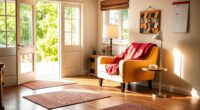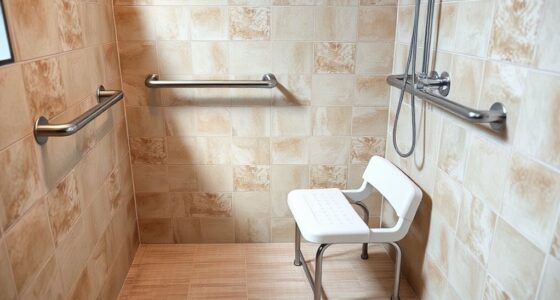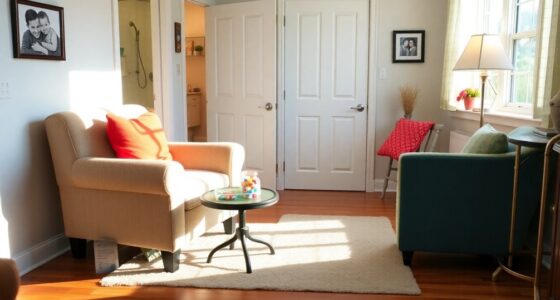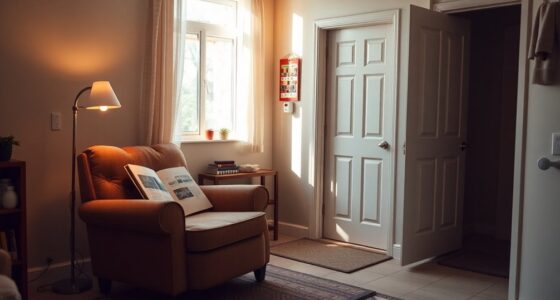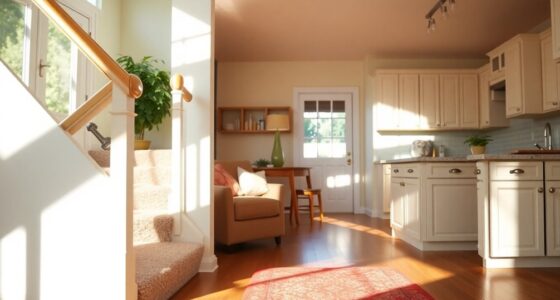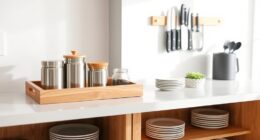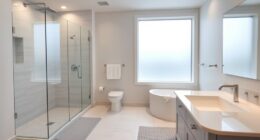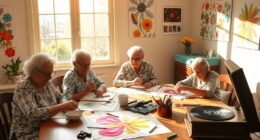As a caregiver, you must implement essential safety modifications at home, since 70% of falls happen in this environment. Start with grab bars in high-risk areas and guarantee adequate lighting to improve visibility. Remove tripping hazards, adjust the kitchen layout for accessibility, and organize living spaces with clear pathways. Don’t forget to use non-slip mats and safety strips and create an outdoor safety plan. There’s even more to discover about enhancing safety for those you care for. Additionally, it’s important to regularly evaluate the home for any new hazards as needs change over time. Consider integrating technology, such as fall detection systems and emergency response devices, to ensure immediate help is available if needed. For more information and practical advice, look for accessibility tips for caregivers that offer further guidance on creating a safer, more accommodating living space.
Key Takeaways
- Install grab bars in bathrooms to provide support and reduce fall risks, especially near bathtubs and showers.
- Ensure adequate lighting in all areas, using bright bulbs and nightlights to improve visibility, especially at night.
- Remove tripping hazards by clearing pathways and securing loose cables; use non-slip mats in key areas to prevent slips.
- Adjust kitchen layouts by lowering counters and organizing frequently used items within easy reach to enhance accessibility.
- Secure stairways with handrails on both sides and install gates to prevent falls, ensuring regular maintenance for safety.
Install Grab Bars in High-Risk Areas
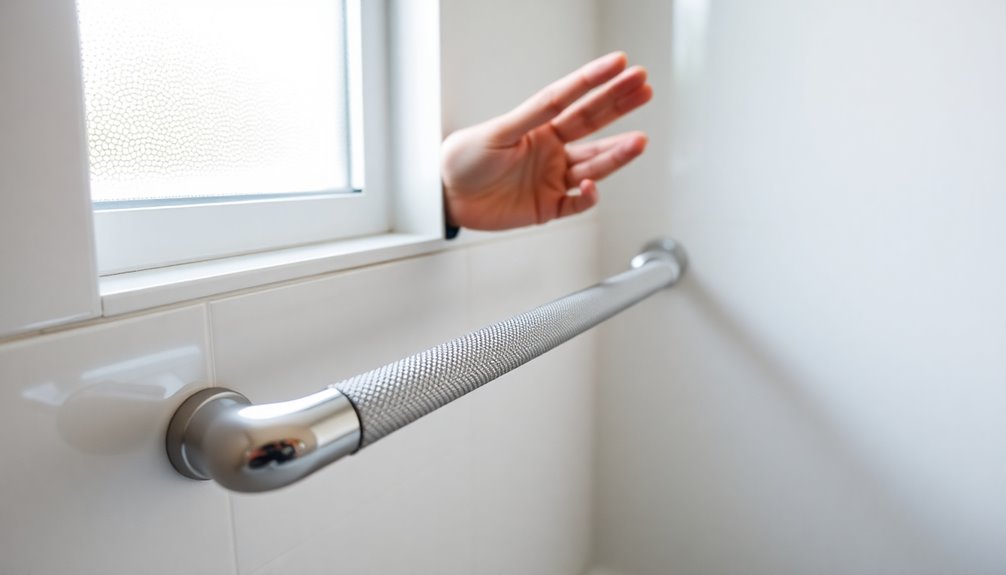
Installing grab bars in high-risk areas like bathrooms and stairways is an essential step in fall prevention. Nearly 70% of falls occur in the home, making it important to install grab bars where slips are likely.
In bathrooms, they provide critical support when getting in and out of bathtubs or showers, greatly reducing the risk of accidents on wet surfaces. Aim to install grab bars at a height of 33 to 36 inches to accommodate various heights and mobility levels.
Make sure they're securely anchored to wall studs; improperly installed bars can fail and lead to injuries. By utilizing grab bars, you can decrease the likelihood of falls by up to 50%, making this modification a key safety enhancement for any caregiver. Additionally, the importance of family stability can be enhanced through such safety measures, as they contribute to a more secure living environment for children and caregivers alike.
Ensure Adequate Lighting Throughout the Home
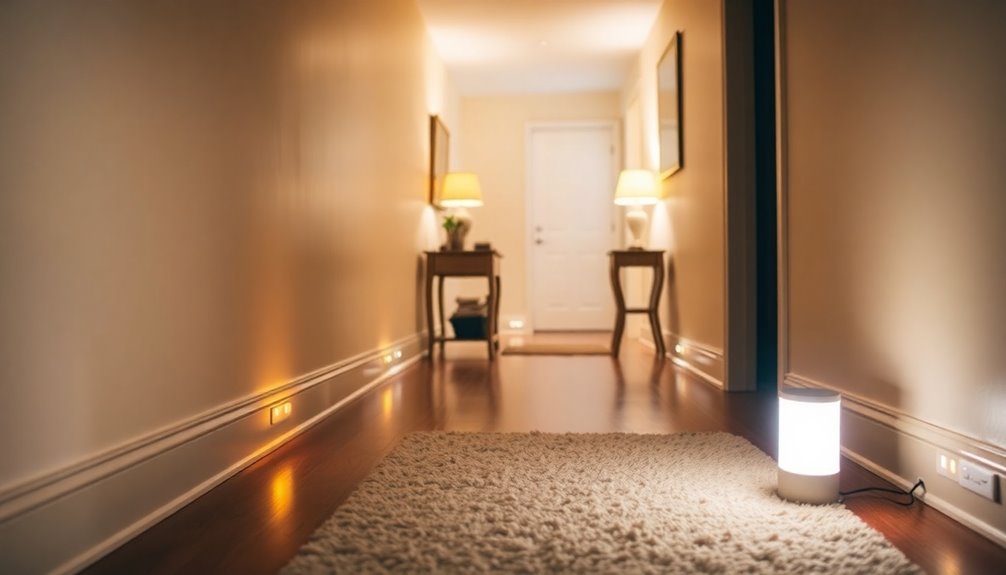
To enhance safety at home, you should strategically install nightlights in key areas like hallways and bathrooms. Using bright, energy-efficient bulbs not only improves visibility but also helps those with declining vision navigate more easily. Regularly checking and replacing bulbs will keep your lighting consistent and effective, reducing the risk of falls. Additionally, consider involving family members in monitoring financial accounts, as they can assist in identifying any safety concerns that may arise in the home environment.
Install Nightlights Strategically
Strategically placing nightlights throughout your home can greatly improve safety during nighttime hours.
These small additions can help protect your loved ones from falls, especially in key areas. Here are three essential spots to take into account:
- Hallways: Guarantee smooth navigation to prevent tripping hazards.
- Staircases: Position lights to illuminate each step, reducing the risk of accidents.
- Bathrooms: Place nightlights to make nighttime visits safer and more comfortable.
Choosing LED and motion-activated nightlights adds convenience and energy efficiency. Additionally, maintaining air purifier filters can enhance overall indoor safety by improving air quality.
Properly heightening these lights guarantees they effectively illuminate pathways, creating a safer environment.
Use Bright, Energy-Efficient Bulbs
Bright, energy-efficient bulbs are essential for creating a safe living environment, especially for those with declining vision. Using bright lighting greatly enhances visibility, reducing the risk of falls and accidents for older adults.
Make certain that high-risk areas, like stairways, hallways, and bathrooms, are well-lit to promote safe navigation throughout the home. Energy-efficient bulbs, such as LEDs, not only provide better lighting but also consume less energy and last longer, offering cost savings over time.
Consider incorporating motion-sensor lights in key areas to improve accessibility during nighttime hours, further decreasing the likelihood of trips and falls. A well-lit environment enhances physical safety and contributes to overall well-being, making your home more inviting for both caregivers and clients. Additionally, improving air quality with air purifiers can further enhance the comfort and health of the living space.
Remove Tripping Hazards From Walking Paths
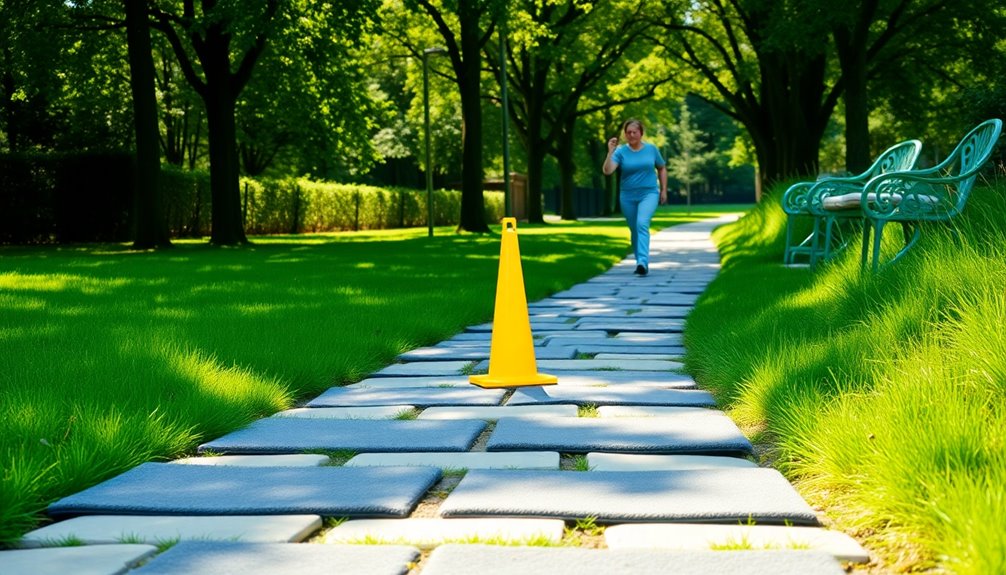
To keep walking paths safe, you should remove any scatter rugs that could cause trips.
Make sure to secure loose rugs and clear out any obstructions in the way.
Creating a clear and open space can greatly reduce the risk of falls in your home.
Clear Pathway Obstructions
While creating a safe environment for seniors, it's essential to remove tripping hazards from walking paths.
Implementing safety precautions guarantees clear pathways for easy navigation. Here are three simple steps you can take:
- Rearrange furniture: Create clear pathways by removing obstacles, allowing safe access to doors and essential areas.
- Tuck away cords: Secure electrical cords and appliance cables along walls to minimize tripping hazards in high-traffic areas.
- Check doors and drawers: Regularly verify closet doors and drawers are closed to prevent sudden obstructions that could lead to falls. Additionally, maintaining optimal air quality in the home can further enhance safety by reducing respiratory risks for seniors.
Secure Loose Rugs
Maintaining clear pathways is just the beginning; securing loose rugs is an essential step to prevent falls. Loose rugs considerably increase the risk of tripping, especially among seniors.
To create a safe environment, eliminate scatter rugs entirely, as they're common hazards. If you need rugs for decor, secure loose rugs with non-slip backing or adhesive strips to prevent movement.
Regularly check carpets for frayed edges and loose areas, as these can also contribute to falls. Arrange furniture to create clear walking paths, minimizing the chance of tripping over unsecured rugs or obstacles in high-traffic areas. Additionally, consider the impact of seasonal changes on household safety, as fluctuating conditions can lead to increased risks.
Modify Bathrooms for Enhanced Safety
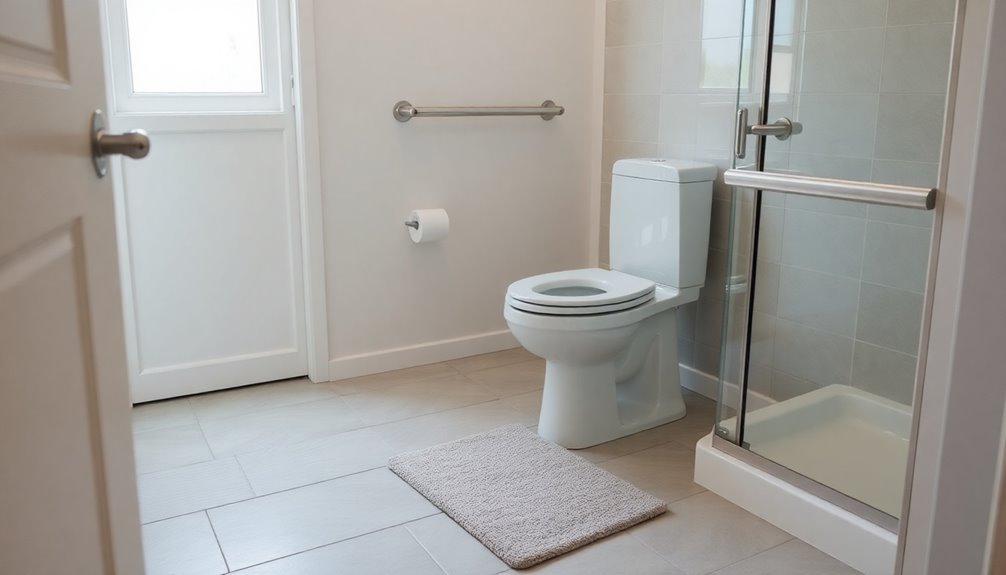
When it comes to guaranteeing safety in the bathroom, implementing specific modifications can make a considerable difference for seniors.
By addressing common safety issues, you can enhance their health and well-being. Here are three essential modifications:
- Install grab bars: Place them in bathtubs and showers to provide support and reduce the risk of falls.
- Use nonskid mats: Add these in shower and tub areas to prevent slipping, a leading safety risk for older adults.
- Improve lighting: Confirm the bathroom has adequate visibility to markedly decrease the chances of accidents.
Additionally, consider assistive devices like 18-inch high toilets or portable commode seats. Implementing these changes can also help in preventing health issues associated with accidents, ensuring a safer environment and giving you peace of mind.
Adjust Kitchen Layout for Accessibility
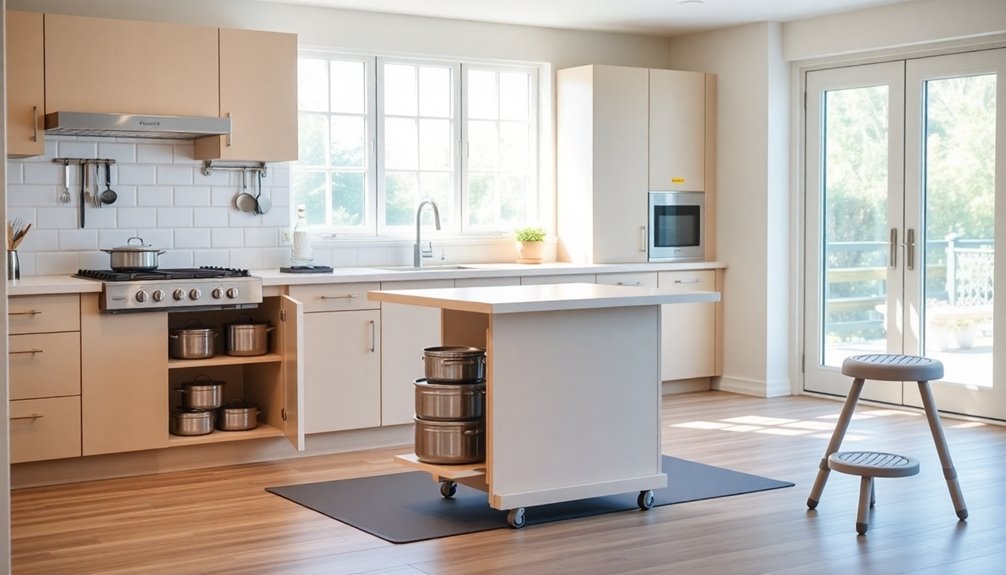
To make your kitchen more accessible, consider lowering counter heights so that everything is within easy reach. This adjustment helps minimize bending or stretching, making it safer for everyone. You can also enhance storage by organizing frequently used items in easy-access locations. Additionally, implementing budget-friendly home appliance maintenance plans can ensure that your kitchen appliances remain efficient and safe to use.
Lower Counter Heights
Adjusting counter heights in your kitchen can make a world of difference for accessibility. By lowering countertops to 28 to 34 inches, you help your loved one feel safe at home while preparing meals.
Here are three modifications to take into account:
- Install Swivel Plates: These can make corner cabinets easy to access, eliminating the need for excessive bending.
- Replace Drawer Knobs with Handles: This small change can improve grip for those with limited hand strength, enhancing kitchen safety.
- Organize Frequently Used Items: Keep essentials within easy reach to reduce the risk of accidents and promote independence.
With these adjustments, you'll create a more accessible kitchen that supports your loved one's needs.
Easy Access Storage
Creating easy access storage in your kitchen is essential for ensuring safety and convenience. Adjusting your kitchen layout can greatly improve your home environment, especially for those with health issues. Lower counter heights let individuals reach items without straining. Swivel plates in corner cabinets and replacing drawer knobs with handles enhances accessibility for those with limited grip strength. Store frequently used items at waist height to avoid bending or stretching. Additionally, removing doors under the sink and insulating pipes allows wheelchair access and prevents burns. Consider a refrigerator with a bottom freezer, making it easier for everyone to reach what they need.
| Modification | Benefit |
|---|---|
| Lower counter heights | Easy reach without strain |
| Swivel plates in cabinets | Access for limited grip strength |
| Waist-height storage | Prevents bending or stretching |
| Open sink area | Wheelchair access, avoids burns |
| Bottom-freezer refrigerator | Enhanced accessibility |
Secure Stairways With Handrails and Gates
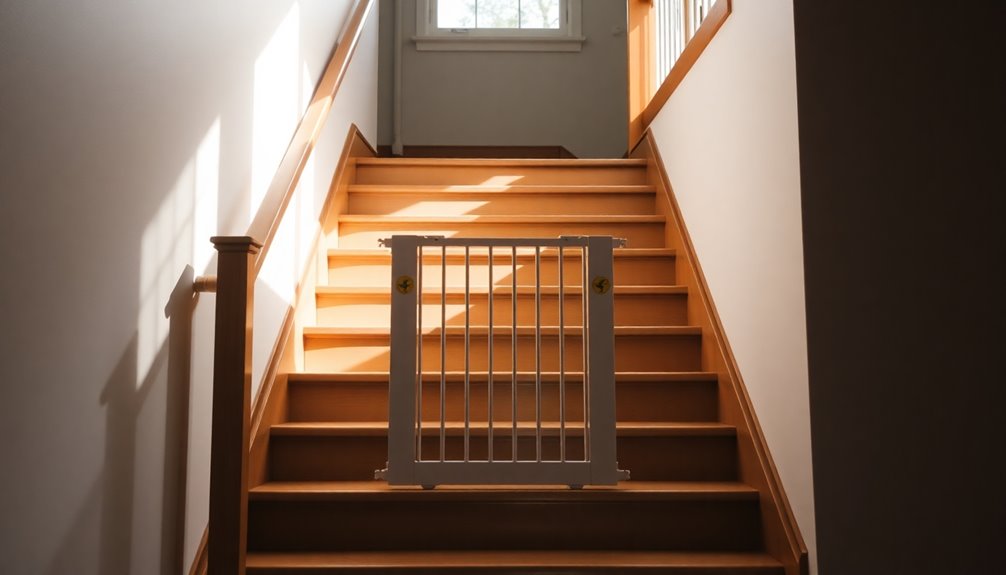
While traversing stairways can be challenging, especially for seniors or young children, securing them with handrails and gates can greatly enhance safety. By making these modifications, you guarantee your family members are secure and can navigate stairs safely.
Here are three key steps to contemplate:
- Install handrails on both sides of the staircase to provide stable support, reducing the risk of falls.
- Place gates at the top and bottom of the stairs to prevent accidental tumbles, especially for young kids or those with cognitive impairments.
- Conduct regular maintenance checks on handrails and gates to guarantee they remain functional and safe, as damage can lead to increased fall hazards.
Taking these measures can considerably lower the risk of accidents in your home.
Organize Living Spaces for Clear Pathways

To enhance safety at home, organizing your living spaces for clear pathways is essential. Start by rearranging furniture to eliminate tripping hazards.
Remember, nearly 70% of falls among seniors happen at home. Remove throw rugs and any furniture that blocks routes to windows and doors to improve mobility for your loved ones. Guarantee at least 36 inches of clearance in pathways, especially for those using walkers or wheelchairs.
Keep electrical cords secured and out of walking areas, as they contribute to 30% of household falls. Finally, add adequate lighting to improve visibility, which can help prevent up to 60% of nighttime accidents. Additionally, consider implementing preventative measures such as using non-slip mats in areas prone to wetness to further reduce fall risks.
Use Non-Slip Mats and Safety Strips

Installing non-slip mats and safety strips in your home can dramatically enhance safety for seniors and those with mobility issues.
These modifications greatly reduce the risk of falls, which account for nearly 70% of accidents among older adults at home.
Here are three key areas to focus on:
- Bathrooms: Place non-slip mats near the shower and sink to prevent slips on wet surfaces.
- Kitchens: Use non-slip mats in front of the sink and stove, where spills are common.
- Stairs and Bathtubs: Install safety strips to provide extra traction and prevent falls.
Remember to regularly check and maintain your non-slip mats and safety strips, as worn-out surfaces can increase accident risks.
Creating a secure environment is essential for both caregivers and those receiving care.
Create an Outdoor Safety Plan

Creating a safe environment extends beyond indoor spaces; an outdoor safety plan is just as important for preventing accidents. Start by guaranteeing all paths and porches are even and free of obstructions. Adequate lighting is essential for nighttime visibility, reducing the risk of trips. Prune branches and shrubs to maintain clear sightlines, helping with navigation. Consider raised planters to avoid bending and promote proper body mechanics. Regularly inspect and repair any broken steps to enhance safety. Additionally, incorporating drainage features in outdoor planters can further prevent water accumulation and slippery surfaces.
| Action Item | Purpose |
|---|---|
| Clear paths and porches | Prevent falls |
| Install outdoor lighting | Improve visibility |
| Prune bushes and branches | Guarantee clear sightlines |
Regularly Assess and Update Safety Measures
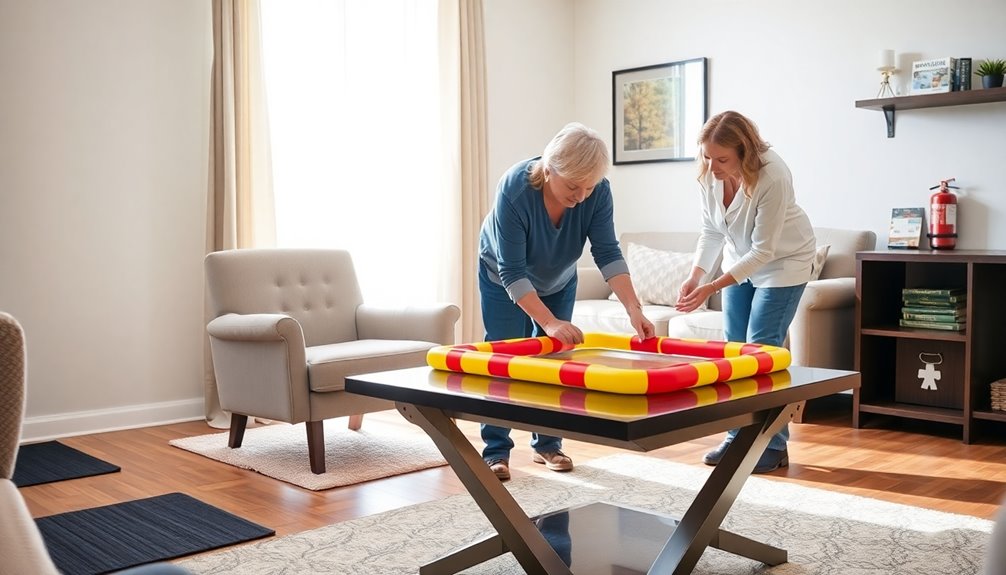
Regularly evaluating and updating safety measures is essential for maintaining a safe living environment, especially as physical changes occur with age.
Accidents involving seniors are alarmingly common, so your vigilance is vital. Here are three key areas to focus on:
- High-Risk Areas: Regularly assess bathrooms and kitchens for modifications like grab bars and non-slip mats to prevent falls.
- Electrical and Fire Safety: Check smoke detectors and electrical systems to avoid potential hazards that could lead to accidents.
- Documentation: Keep a record of safety evaluations and modifications to stay informed and to communicate effectively with family members and healthcare professionals about safety plans.
Frequently Asked Questions
What Is the Safety Procedure of Caregiving?
When you think about the safety procedure of caregiving, it's essential to assess the environment for hazards and maintain open communication with your clients.
Regularly inspect safety features like smoke detectors and grab bars, and use proper lifting techniques to avoid injury.
Creating an emergency plan tailored to your client's needs guarantees you're prepared for any situation.
What Do Caregivers Need the Most?
As a caregiver, you need support and resources to manage your responsibilities effectively. Access to training, emotional support, and respite care can help you balance your duties, especially if you're also working outside the home.
It's essential to have effective communication with your clients and their families to understand their needs better.
Prioritizing your well-being through self-care and breaks is equally important to avoid burnout and maintain high-quality care.
What Can a Caregiver Prevent by Taking Safety Training?
Did you know that over 2.3 million accidents involving seniors happen each year?
By taking safety training, you can greatly reduce these risks. You'll learn to identify hazards in the home, practice proper lifting techniques, and understand infection control measures, all of which help prevent injuries for both you and your clients.
Plus, mastering emergency preparedness guarantees you're ready for any crisis, creating a safer environment for everyone involved.
How Do You Promote Safety in Patients With Dementia?
To promote safety in patients with dementia, you need to create a secure environment.
Start by installing locks on cabinets to keep harmful items out of reach. Use clear labels to help them navigate their space.
Verify all areas are well-lit to prevent falls, and remove any clutter or loose rugs.
Finally, consider using monitoring devices to alert you if they wander.
These steps can greatly enhance their safety and well-being.
Conclusion
By implementing these safety modifications, you can greatly reduce the risk of accidents in your caregiving environment. Did you know that according to the Centers for Disease Control and Prevention, falls are the leading cause of injury among older adults, accounting for over 3 million emergency department visits each year? By taking proactive steps like installing grab bars and ensuring proper lighting, you're not just enhancing safety; you're also promoting independence and well-being for those you care for.

